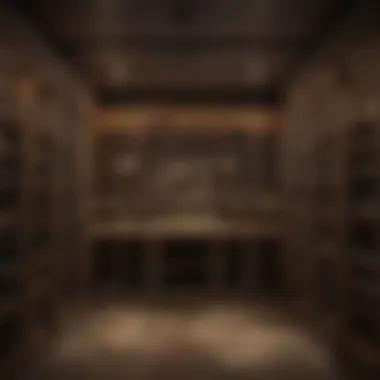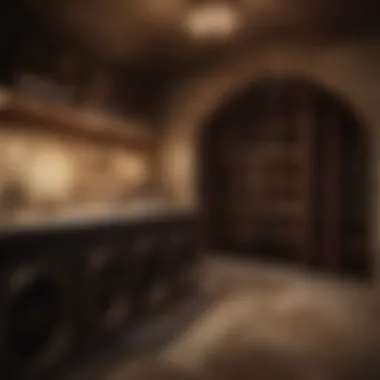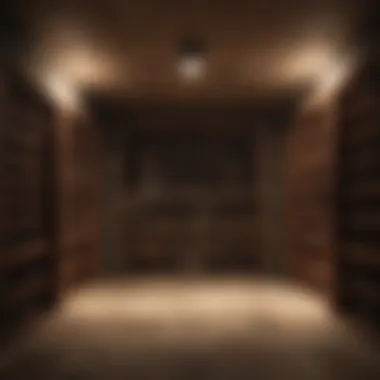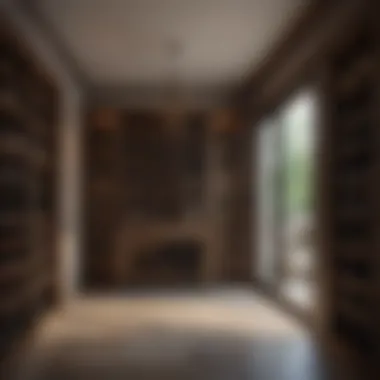Crafting a Luxurious Wine Cellar in Your Basement: A Complete Guide to Elegance and Functionality


Materials:
When embarking on the exciting journey of creating a wine cellar in your basement, it is essential to gather all the necessary materials to ensure a seamless construction process. Here is a detailed list of materials, painstakingly curated to meet your needs:
-
Insulation Materials
- Rigid foam insulation boards (quantity: 15, dimensions: 4ft x 8ft)
- Foam adhesive spray (2 cans)
-
Wall Materials
- Moisture-resistant drywall (quantity: 20 sheets, dimensions: 4ft x 8ft)
- Drywall screws (2 boxes)
-
Flooring Materials
- Ceramic tiles (quantity: 5 boxes, style: slate gray)
- Tile adhesive (1 gallon)
- Grout (2 bags, color: charcoal)
-
Wine Racks
- Wooden wine racks (dimension: customizable, capacity: 100 bottles)
- Corner wine rack unit (1 unit)
DIY Steps:
With all the materials in hand, it's time to dive into the DIY process of creating your dream wine cellar. Follow these detailed instructions carefully for a successful outcome:
-
Preparing the Space
- Clear out the basement area completely.
- Measure and mark the layout of your wine cellar.
-
Insulation Installation
- Cut the rigid foam insulation boards to fit the walls.
- Apply foam adhesive spray to affix the insulation boards securely.
-
Wall Construction
- Install the moisture-resistant drywall using drywall screws.
- Ensure a tight and secure fit for maximum insulation.
-
Flooring Installation
- Lay out the ceramic tiles according to your planned design.
- Use tile adhesive to fix the tiles in place and apply grout for a polished finish.
Technical Aspects:
To elevate the quality and functionality of your wine cellar, pay close attention to the technical details and tools involved in the construction process:
- Tools Required: Drill, saw, measuring tape, screwdriver
- Timing Specifics: Plan for approximately 2-3 weekends to complete the wine cellar
- Critical Techniques: Ensure proper insulation for temperature control
DIY Project Process:


As you progress through the installation of your wine cellar, here are some key sequential steps to guide you through the process, along with troubleshooting tips to address any potential hiccups:
-
Sequential Installation Method: From insulation to flooring, follow a methodical approach for a structurally sound wine cellar.
-
Key Techniques: Properly sealing joints for insulation efficiency.
-
Timings: Allow adhesive and grout to cure for 24-48 hours before placing wine racks.
-
Troubleshooting Tips: In case of gaps in insulation, use additional spray foam to fill the spaces.
By adhering to these meticulous instructions and technical insights, you are well on your way to enjoying the fruits of your labor with a beautifully crafted wine cellar in your very own basement!
Prologue


Welcome to the journey of creating your very own wine cellar in the comfort of your basement. Within these intricately crafted walls lies the essence of sophistication and practicality, where each bottle tells a story and every sip is an experience. Today, we embark on a quest to transform a mere storage space into a sanctuary for wine enthusiasts and aficionados alike.
In this article, we will delve deep into the art of creating a wine cellar in your basement, exploring every nuance from initial planning to the final aesthetic touches. Whether you are a seasoned collector or just beginning your foray into the world of oenology, this guide is tailored to elevate your understanding and appreciation of wine storage.
As we unravel the layers of planning and execution, you will come to appreciate the meticulous attention to detail required in constructing a functional yet visually appealing wine cellar. From understanding the spatial dynamics of your basement to selecting the most suitable storage solutions, each decision contributes to the overall ambiance of your cellar.
Through this comprehensive resource, you will gain insights into the key considerations that go into building a wine cellar, from the practical aspects of insulation and climate control to the creative aspects of decor and personalization. By the time you reach the conclusion of this guide, you will be equipped with the knowledge and inspiration to curate a wine cellar that not only preserves your collection but also elevates your wine-tasting experience to new heights.
Join us on this immersive journey into the world of wine cellar construction, where every detail matters and every choice reflects your affinity for the divine nectar. Let the transformation begin, as we navigate through the intricacies of designing and building a wine cellar that truly embodies your passion for fine wines.
Planning and Preparation


In the realm of creating a wine cellar in your basement, one cannot underestimate the vital role that planning and preparation undertake. Meticulous planning is the backbone of a successful wine cellar project, dictating space utilization, storage capacity, budget allocation, and regulatory compliance. Without a solid plan in place, your wine cellar venture could encounter various challenges and setbacks. By dedicating ample time and effort to the preliminary phases of planning and preparation, you set the stage for a seamless and gratifying construction journey.
Assessing Space Availability
The first step in your wine cellar odyssey involves assessing the available space in your basement with scrupulous precision. Measure the dimensions of the area earmarked for the wine cellar, considering both horizontal and vertical space constraints. Factor in any obstructions or irregularities that could impact the layout and design. Conduct a thorough inspection to identify potential structural limitations that may necessitate modifications. By gauging space availability keenly, you can embark on the subsequent stages of designing and construction with clarity and purpose.
Determining Storage Capacity Needs
Delving into the realm of storage capacity requirements is paramount in crafting an effective wine cellar. Evaluate your collection size and future growth projections to ascertain the suitable storage capacity. Whether you are an avid collector with an extensive repertoire or a casual enthusiast building a modest stock, understanding your storage needs is instrumental. Consider implementing diverse storage solutions based on bottle sizes, ensuring flexibility and optimization of space. By meticulously determining your storage capacity needs, you can tailor your wine cellar to accommodate your collection seamlessly.
Setting a Budget
Embarking on the endeavor of constructing a wine cellar warrants prudent financial planning. Setting a realistic and inclusive budget is fundamental to navigating the various expenses associated with the project efficiently. Account for costs related to materials, labor, equipment, permits, and unforeseen contingencies when formulating your budget. Conduct market research to procure competitive quotes and explore cost-saving strategies without compromising quality. By establishing a comprehensive budgetary framework, you can pursue your wine cellar aspirations with financial prudence and foresight.
Researching Local Regulations
Navigating the labyrinth of local regulations is a crucial aspect of preparing for your wine cellar construction. Familiarize yourself with building codes and zoning ordinances pertinent to cellar installations in your area. Seek guidance from regulatory authorities or consult with seasoned professionals to ensure adherence to legal requirements. Consider factors such as ventilation standards, fire safety protocols, and structural guidelines when researching local regulations. By proactively engaging with regulatory compliance, you safeguard your project against potential inefficiencies and setbacks while fostering a compliant and secure wine cellar environment.
Design and Layout
In the realm of creating a wine cellar in your basement, the Design and Layout phase emerges as a pivotal cornerstone constituting the very essence of functionality and visual appeal. As one embarks on this journey of oenophilic indulgence, meticulous attention to this segment ensures the seamless integration of both practical utility and aesthetic charm. A well-thought-out Design and Layout strategy not only optimizes space but also elevates the entire wine cellar experience to a realm of sophistication and elegance. Delving into the specifics, considerations about Design and Layout encompass aspects such as the efficient utilization of available space, strategic placement of storage units to facilitate easy access, and the harmonious blending of form and function.
Optimizing Storage Space
Within the domain of wine cellar creation, the task of optimizing storage space assumes paramount importance. The judicious allocation of space to accommodate various types of wine bottles, from standard to magnum sizes, demands careful planning and organization. By employing space-saving storage solutions such as modular shelving units and adjustable racks, wine enthusiasts can maximize capacity while ensuring convenient accessibility to their prized collections. Furthermore, factors like temperature consistency and bottle orientation play a crucial role in preserving the quality of wines over time, underscoring the significance of thoughtful spatial design in the storage environment.
Selecting Shelving and Racks
The process of selecting shelving and racks for your wine cellar entails a nuanced balance between practical functionality and aesthetic appeal. Opting for sturdy, moisture-resistant materials like wood or metal not only ensures the structural integrity of the storage units but also adds a touch of refined elegance to the cellar's ambiance. Considerations such as adjustable shelving heights to accommodate diverse bottle dimensions, as well as specialized racks for organizing sparkling wines or large-format bottles, contribute to a well-organized and visually pleasing storage arrangement. By integrating shelving and racks that align with your specific storage needs and design preferences, you can curate a cellar that harmoniously blends form and function.
Choosing Lighting Options
In the realm of wine cellar design, the right lighting can serve as a transformative element that accentuates the beauty of your collection while creating a conducive ambiance for tastings and gatherings. Selecting lighting options that balance functionality with aesthetics is crucial in showcasing your wines in their best light, both figuratively and literally. LED lighting fixtures offer energy-efficient solutions that emit minimal heat, safeguarding the optimal storage conditions for wines. Moreover, customizable lighting controls allow for varying intensities to suit different occasions, adding a layer of versatility to the cellar's atmosphere. By carefully considering factors like color temperature, placement of lighting fixtures, and light distribution, you can curate a visually striking and functionally efficient lighting scheme that enhances the overall allure of your wine cellar.
Construction Process
In the realm of creating a wine cellar in your basement, the construction process carries paramount significance. This phase embodies the transformation from mere concept to physical reality. The intricacies of this process extend far beyond the surface, delving into a realm where functionality meets craftsmanship. One must approach this stage with meticulous attention to detail, ensuring that every element aligns harmoniously to culminate in a wine cellar of both practicality and elegance. The construction process serves as the backbone upon which the entire wine storage space is built. From laying the foundations to installing the final touches, each step paves the way for a wine cellar that not only houses your collection but elevates your entire home's ambiance.
Insulation and Climate Control
When delving into the construction process of a wine cellar, insulation and climate control emerge as fundamental pillars. Insulation plays a pivotal role in maintaining stable temperatures within the cellar, safeguarding your prized wine collection from external fluctuations. The type of insulation chosen must exhibit superior thermal resistance to create an environment conducive to aging wine gracefully. Simultaneously, climate control mechanisms ensure that humidity levels remain optimal, preserving the integrity of your wines. A seamless integration of insulation and climate control guarantees a consistent environment essential for the proper maturation of wine.
Installing Flooring
Amidst the intricacies of constructing a wine cellar, the choice of flooring stands out as a determining factor in both functionality and aesthetics. The flooring must withstand the weight of wine bottles and racks while possessing moisture-resistant properties to combat potential cellar dampness. Furthermore, the selected flooring should complement the overall design scheme, enhancing the cellar's visual appeal. Whether opting for durable tiles or classic hardwood, the flooring installation phase intertwines practicality with style, laying the groundwork for a cohesive and captivating wine cellar design.
Ventilation and Humidity Management
Ventilation and humidity management represent vital components in the construction process of a wine cellar. Adequate ventilation ensures proper air circulation, preventing musty odors and mold growth within the confined space. Moreover, effective humidity management safeguards against excessive moisture that could damage wine labels and corks. By integrating strategic ventilation systems and humidity controls, one cultivates an environment that not only preserves wine quality but also enhances the longevity of the cellar itself.
Door Selection and Installation
The selection and installation of doors within a wine cellar play a dual role of functionality and aesthetics. The chosen door should provide a tight seal to uphold insulation efficiency, contributing to temperature consistency. Simultaneously, the design and material of the door contribute to the overall allure of the cellar, accentuating its entrance as a focal point. Whether opting for a contemporary glass door to showcase your collection or a solid wood door for a traditional touch, the careful selection and installation of this element add a defining touch to your basement wine sanctuary.
Wine Cellar Essentials
When delving into the realm of creating a wine cellar in your basement, understanding the significance of Wine Cellar Essentials becomes paramount. These crucial components are the foundation upon which your prized wine collection will thrive, ensuring optimal storage conditions and preserving the quality of your wines. From temperature control to security, every detail plays a vital role in maintaining a sophisticated and functional wine storage space.
A key aspect of Wine Cellar Essentials is the implementation of efficient Wine Cooling Systems. These systems are designed to regulate the temperature and humidity levels within the cellar, creating an ideal environment for aging wines gracefully. By investing in a high-quality cooling system, you not only enhance the preservation of your wines but also elevate the overall appeal of your cellar.
In addition to temperature control, Organizing and Cataloging Your Collection is another critical facet of Wine Cellar Essentials. Proper organization not only enhances the visual appeal of your cellar but also facilitates easy access to your wines. Implementing a systematic cataloging system allows you to track your collection effectively, ensuring that each bottle is stored and retrieved with care.
Moreover, Security Measures play a crucial role in safeguarding your treasured wine collection. Integrating robust security systems such as surveillance cameras, alarms, and secure locks adds an extra layer of protection to your cellar. By prioritizing security, you can enjoy peace of mind knowing that your wines are safe and secure.
Finishing Touches and Aesthetics
In the realm of wine cellars, the Finishing Touches and Aesthetics play a pivotal role in elevating the overall ambiance and functionality of the space. This section delves into the crucial aspects that contribute to making your cellar not just a storage area but a captivating masterpiece. When it comes to Finishing Touches, attention to detail is paramount. From the choice of materials for the flooring to the colors of the walls, each decision impacts the aesthetics and feel of the cellar. Opting for high-quality finishes can enhance the durability and visual appeal of the space, creating a welcoming environment for your prized wine collection.
Aesthetics go beyond mere visual appeal; they encompass the sensory experience that the cellar offers. Lighting, for instance, is a crucial element that can accentuate the beauty of your wines while also serving a functional purpose. The right lighting can highlight your collection, add warmth to the space, and create a cozy atmosphere for wine tasting and enjoyment. Moreover, incorporating personalized decor elements can infuse the cellar with your unique style and personality, transforming it into a reflection of your taste and passion for wine.
When considering the Finishing Touches and Aesthetics of your wine cellar, it is essential to strike a balance between style and practicality. While aesthetics play a significant role in creating a visually appealing space, functionality should not be compromised. Balancing design elements with functional considerations ensures that your wine cellar not only looks stunning but also serves its intended purpose effectively. By paying attention to the details and infusing your personal touch, you can create a wine cellar that is both visually captivating and functionally efficient.
Decor and Personalization
The Decor and Personalization of your wine cellar play a crucial role in creating a space that is uniquely tailored to your preferences and style. Decor goes beyond mere ornamentation; it involves choosing elements that reflect your personality and enhance the ambiance of the cellar. From selecting furniture pieces and artwork to incorporating decorative accents, every choice contributes to the overall theme and feel of the space.
Personalization is key to making your wine cellar truly yours. Whether you opt for a rustic, traditional look or a modern, sophisticated design, the decor choices you make reflect your individual taste and passion for wine. Personalizing the cellar with items that hold sentimental value or cultural significance can add depth and character to the space, making it more than just a storage area for your wine collection.
When it comes to decor and personalization, consider incorporating elements that not only enhance the visual appeal of the cellar but also enrich your wine-tasting experience. Comfortable seating arrangements, tasteful decor accents, and personalized touches can create a welcoming atmosphere where you can relax, unwind, and savor your favorite wines. By infusing your personal style into the decor of your wine cellar, you can transform it into a retreat that reflects your love for wine and hospitality.
Climate Monitoring Systems
Among the essential components of a well-functioning wine cellar, Climate Monitoring Systems play a critical role in maintaining the ideal storage conditions for your wines. Ensuring that the temperature and humidity levels are consistently regulated is crucial for preserving the quality and flavor of your wine collection. Climate monitoring systems provide real-time data on the environmental conditions in the cellar, allowing you to make adjustments as needed to create the optimal storage environment.
By investing in a quality climate monitoring system, you can protect your wines from potential damage due to fluctuations in temperature and humidity. These systems offer advanced features such as temperature alarms, humidity sensors, and remote monitoring capabilities, giving you peace of mind knowing that your wines are stored in optimal conditions. Additionally, some climate monitoring systems are designed to integrate with smart home technologies, allowing you to control and monitor the cellar environment conveniently.
When selecting a climate monitoring system for your wine cellar, consider factors such as accuracy, reliability, and user-friendliness. Opt for a system that can provide precise data readings and alerts in case of any deviations from the recommended storage conditions. By incorporating a climate monitoring system into your wine cellar, you can ensure that your precious collection is well-protected and aged to perfection.
Maintenance and Upkeep
Maintenance and upkeep are critical aspects of ensuring the longevity and optimal performance of your basement wine cellar. By adhering to a regular maintenance routine, you can preserve the quality of your wine collection and the functionality of your storage space. Cleaning and organizing your cellar is not just about aesthetics but also plays a vital role in preventing mold growth, maintaining proper airflow, and protecting your wines from contamination.
Regular cleaning is essential to remove dust, cobwebs, and any potential mold or mildew growth. Use a gentle cleaning solution and a soft cloth to wipe down shelves, racks, and flooring. Ensure that no cleaning products with strong odors are used to avoid tainting the cork or affecting the wine's flavor. Organizing your collection effectively not only enhances the visual appeal of your wine cellar but also makes it easier to locate specific bottles. Group wines by type, region, or varietal to streamline your selection process and avoid unnecessary handling of bottles.
Cleaning and Organization Tips
To maintain a pristine wine cellar, develop a cleaning schedule that includes dusting shelves and bottles regularly, vacuuming or mopping the floor, and inspecting for any signs of pests or leaks. Use a mild soap and water solution for cleaning, avoiding harsh chemicals that can impact the aroma and taste of the wine. Keep an inventory of your wines and label shelves clearly to facilitate systematic organization and easy access to your collection.
Regular Inspections and Maintenance Checks
Periodic inspections are fundamental to identifying and addressing potential issues before they escalate. Conduct routine checks on the cellar's temperature and humidity levels to ensure they remain within the optimal range for wine storage. Inspect seals on doors, windows, and vents to prevent air leaks that could compromise insulation and climate control. Check for any water damage, mold growth, or pest infestations, taking immediate corrective measures if any concerns arise.
Epilogue
As we reach the conclusion of this comprehensive guide on creating a wine cellar in your basement, it's crucial to reflect on the journey you've undertaken. Building a wine cellar is not just about storage; it's an art form that combines functionality with aesthetics.
One of the key elements to consider in the conclusion is the meticulous planning and attention to detail required throughout the process. From assessing space availability to selecting the right materials and cooling systems, every decision contributes to the overall success of your wine cellar.
Moreover, the benefits of investing time and effort into constructing a wine cellar are vast. Not only does it provide a secure and controlled environment for your wine collection, but it also adds significant value to your home. Imagine the joy of showcasing your carefully curated wines in a space designed to enhance their flavors and age gracefully.
When contemplating the conclusion of this project, it is essential to consider the ongoing maintenance and upkeep required for your wine cellar. Regular inspections, cleaning routines, and climate monitoring ensure that your wines are stored in optimum conditions, allowing them to mature gracefully over time.



